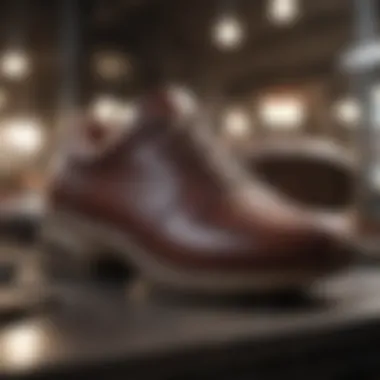Sustainable Fashion Shoes: A Comprehensive Approach


Intro
The demand for sustainable fashion shoes has grown significantly in recent years. Society is becoming more aware of the impact that traditional shoe production has on the environment and on workers' rights. Shoes are more than just accessories; they reflect personal values and a commitment to sustainable living. This interest in sustainability extends beyond the surface, examining the materials, processes, and ethics behind each pair of shoes.
As consumers, we hold the power to influence the industry. Understanding sustainable fashion is more than a trend; it is a paradigm shift toward eco-conscious practices. This article aims to highlight the numerous facets of sustainable fashion shoes, including the key trends shaping the industry, the practices that define sustainability, and the role of consumers in this important movement.
Key Trends
Overview of Current Fashion Trends
The landscape of fashion continually evolves, with sustainability now at the forefront. New generations prioritize brands that reflect their values. In footwear, trends such as minimalist designs, transparent production practices, and a focus on durable materials have emerged. Consumers are searching for shoes made from organic cotton, recycled plastics, or even biodegradable materials. Aquafresh footwear and the use of evahair are becoming more common.
Popular Sustainability-driven Footwear Brands
- Allbirds: Known for their use of renewable materials like merino wool.
- Rothy's: Specializes in shoes made from recycled plastic bottles.
- Veja: Combines ethical production with stylish designs.
- Toms: Has a one-for-one model, promoting social causes with each purchase.
Sustainable Practices
Understanding Sustainable Fashion
To comprehend sustainable fashion, we must first define its core principles. This concept encompasses environmentally friendly materials, ethical labor practices, and long-lasting durability. Sustainable fashion seeks to minimize waste and pollution, ensuring that both humans and the planet benefit.
Ethical Production Processes
Sustainable shoes often undergo rigorous practices to minimize their footprint. These include sourcing raw materials responsibly, implementing fair labor practices, and employing energy-efficient manufacturing techniques. Brands that prioritize sustainability often provide transparency about their processes, allowing consumers to make informed choices.
Tips for Sustainable Footwear Choices
- Research Brands: Look for companies that emphasize sustainability.
- Opt for Quality: Invest in durable shoes that will last longer.
- Support Local: Choose local artisans or brands to reduce carbon emissions associated with shipping.
- Recycle Represents: Participate in recycling programs for worn-out shoes.
- Buy Second-Hand: Thrift shopping can be an eco-friendly alternative.
"Sustainability is not just a trend; it embodies a shift in how we think about our purchases and their impact on the world."
As the conversation around sustainable fashion shoes evolves, the intersection of consumer awareness and innovative solutions plays a crucial role. By understanding the trends and practical approaches, each of us can contribute to the future of footwear sustainability.
Preface to Sustainable Fashion Shoes
The modern fashion landscape faces critical challenges. Among them, the environmental impact of footwear production is significant. The introduction of sustainable fashion shoes is an essential step toward addressing these challenges. This initiative combines ethical responsibility with stylish design, meeting consumer demand for environmentally-friendly options.
Understanding Sustainable Fashion
To comprehend sustainable fashion, it's crucial to examine its core principles. Sustainable fashion emphasizes minimizing what can harm the environment. This includes using materials that have a reduced ecological footprint and ensure long-term durability. The commitment to sustainability affects every aspect of the fashion industry, but its application to shoes is vital. Using organic fabrics, for example, minimizes pesticide usage and conserves resources.
Moreover, sustainable fashion endorses the idea of reducing waste in the production cycle. By prioritizing quality over quantity, brands can offer products that last longer, thereby reducing the overall demand for new items. Consumers begin to see sustainable fashion not just as a trend, but as a vital movement that can change the way the industry operates.
The Role of Footwear in Sustainable Fashion
Footwear is a significant contributor to the fashion ecosystem. By nature, shoes require diverse materials, including leather, plastic, and rubber. Traditional production methods often lead to excessive waste and pollution. However, sustainable fashion shoes are designed to counter these effects.
These shoes use materials sourced responsibly, such as recycled plastics or natural rubber. They often focus on energy-efficient manufacturing processes. Addressing ocean pollution by converting plastic waste into footwear not only meets consumer needs but actively participates in environmental remediation.
"Sustainable fashion is not just a trend; it's a critical necessity for our planet."
Through the thoughtful integration of eco-friendly materials and ethical practices, the sustainable footwear movement is building a resilient foundation for the future of fashion.
Materials Used in Sustainable Shoes
The choice of materials is crucial in sustainable footwear. Sustainable shoes rely on materials that minimize environmental impact. This entails examining the sources of these materials, their production processes, and end-of-life options. Using sustainable materials can aid in reducing waste, promoting environmentally friendly practices, and supporting ethical manufacturing. By prioritizing eco-friendly materials, the fashion industry can significantly lower its carbon footprint.
Eco-Friendly Fabrics
Eco-friendly fabrics play a significant role in sustainable shoe production. They mitigate the destructive effects of traditional materials on the environment, providing a responsible alternative.


Organic Cotton
Organic cotton is a standout among eco-friendly materials. It is cultivated without synthetic fertilizers or pesticides. This aspect not only benefits the environment but also the farmers. Because of this sustainable method, organic cotton remains free from toxic substances. A key characteristic is its breathability and softness, making it suitable for various footwear styles. The durability of organic cotton also contributes to longer product lifespan. However, it can be more expensive due to the farming practices involved.
Bamboo
Bamboo has gained attention as a sustainable option. This plant grows quickly and requires minimal water compared to traditional crops. Its fibers are naturally antibacterial, making bamboo shoes more hygienic. A unique feature is its biodegradability, which reduces landfill waste. However, bamboo production needs to be carefully managed to prevent habitat loss.
Recycled Materials
Recycled materials are an innovative approach in sustainable footwear. Utilizing waste products like plastic bottles or discarded fabrics transforms them into valuable resources. A major benefit is the considerable reduction of waste in landfills. Furthermore, using recycled materials often requires less energy than creating new materials. However, the quality can vary based on the recycling process used, affecting durability.
Biodegradable Alternatives
Biodegradable alternatives represent a significant leap in shoe sustainability. They break down naturally, reducing long-term environmental damage.
Natural Rubber
Natural rubber is derived from rubber trees, providing a renewable resource. Its elasticity and durability make it suitable for various applications in footwear. This material stands out because it does not produce harmful toxins during its breakdown. Although it has a lower carbon footprint, sourcing can affect rubber tree ecosystems if not managed sustainably.
Plant-Based Leather
Plant-based leather offers an alternative to animal leather, appealing to many consumers. This innovative material is often made from plants like mushroom or apple waste. Key advantages include reducing animal farming's ethical implications and environmental impact. It is essential to ensure that these alternatives are also non-toxic. Quality concerns and performance can sometimes be drawbacks, yet ongoing innovations are improving these aspects.
"Choosing the right materials is the foundation for creating sustainable footwear. It's about understanding our choices and their implications on the environment."
The materials used in sustainable shoes reflect a conscious effort to support eco-friendly practices. They contribute to reducing waste and promoting a greener future in fashion.
Production Processes in Sustainable Footwear
The relevance of production processes in sustainable footwear is paramount in advancing the concept of eco-conscious fashion. Sustainability is not merely about the materials used; it extends into the methods of manufacturing and the entire production cycle. By prioritizing ethical practices and transparency, the footwear industry can significantly lessen its environmental impact. This section delves into critical elements, benefits, and considerations regarding the production processes involved in sustainable footwear.
Ethical Manufacturing Practices
Ethical manufacturing practices are foundational to the creation of sustainable shoes. These practices ensure that workers are treated fairly and that their rights are upheld throughout the production chain. Factors such as safe working conditions, fair wages, and reasonable working hours are essential to creating a just system. For instance, companies that support fair trade principles not only enhance the quality of life for their workers but also contribute to social equity within local communities.
Furthermore, ethical manufacturing often involves reducing environmental hazards. Footwear brands that adopt cleaner production methods can minimize pollution and waste. This includes using non-toxic dyes and sustainable production techniques that conserve water and energy. By choosing brands that practice ethical manufacturing, consumers align their purchases with their values, promoting a broader movement towards responsible consumerism.
Transparency in Supply Chains
Transparency in supply chains is another critical aspect of sustainable footwear production. It refers to the clarity and openness brands exhibit regarding where and how their products are made. Consumers increasingly demand to know the origins of their shoes, including the materials used and the conditions under which they were produced.
Effective transparency can involve sharing detailed information about suppliers, production facilities, and labor practices. Brands like Allbirds and Veja exemplify this by openly communicating about their sourcing strategies and environmental impact assessments. Such practices not only build trust with consumers but also encourage brands to remain accountable for their manufacturing processes.
Moreover, transparency can help identify areas for improvement within the supply chain. For example, if a company discovers that one of its suppliers does not adhere to ethical labor standards, it can take corrective actions to address the situation. This proactive approach contributes to a more sustainable and ethical fashion landscape.
"Ethical practices and transparency in the production processes of sustainable footwear shape a responsible fashion culture."
Popular Sustainable Shoe Brands
Sustainable shoe brands are crucial for supporting eco-conscious choices in fashion. They offer alternatives that reduce environmental impact while ensuring style and comfort. By choosing these brands, consumers can make a statement about their values and priorities. In this section, we will explore some leading examples in sustainable footwear. They are pioneering efforts to innovate while caring for the planet.
Pioneers of Sustainable Footwear
Brand A
Brand A is renowned for its commitment to using recycled materials in its shoe production. This approach significantly reduces waste generated in the fashion industry. One of the key characteristics of Brand A is its innovative processes, which transform discarded plastic into fashionable footwear. This makes them a popular choice for eco-conscious consumers.
Unique features of Brand A include its stylish design that does not compromise on performance. The shoes are known for their durability and comfort, appealing to those seeking reliable footwear. However, some may find the price point slightly higher than conventional brands. Yet the investment aligns with values supporting sustainable practices.
Brand B
Brand B stands out by emphasizing transparency in its supply chain. They provide extensive information about the materials sourced and the ethical practices involved in manufacturing. This key characteristic makes Brand B a leading figure in sustainable fashion. Their dedication assures consumers that their purchases contribute positively to the environment and society.


A unique feature of Brand B is its utilization of plant-based leathers, which offer an alternative to animal-derived materials. This move aligns well with growing demands for cruelty-free products. Some consumers, however, may have concerns regarding the longevity of plant-based leather compared to traditional materials. Nonetheless, Brand B continues to gain popularity for its ethical approach to fashion.
Innovative Startups in the Industry
Startup
Startup C has emerged as an exciting player in sustainable footwear. Their innovative use of biodegradable materials distinguishes them from traditional brands. This method ensures that the shoes will decompose at the end of their life cycle, reducing landfill waste. This characteristic attracts environmentally conscious consumers looking for practical solutions.
The unique feature of Startup C is its commitment to local production. This strategy not only decreases the carbon footprint associated with shipping but also supports local economies. Some critics may point out potential limitations in scale, given the focus on local manufacturing, but the brand’s appeal lies in its sustainable and community-focused practices.
Startup
Startup D focuses heavily on customization for sustainable wear. They allow consumers to design shoes that suit personal style preferences while utilizing eco-friendly methods. The key characteristic of Startup D is its user-centric approach, which encourages mindful consumption. This feature resonates with an audience increasingly interested in personalized fashion.
Their unique process involves using minimal waste in production, which further enhances their sustainable image. Although customization may lead to longer wait times for delivery, many customers feel the personalized touch justifies the delay. Consequently, Startup D represents a fresh approach to sustainable shoe branding.
Consumer Awareness and Demand
Consumer awareness is critical for the growth and sustainability of fashion shoes. This section analyzes how informed choices made by consumers can directly influence the demand for sustainable footwear. Consumers today are becoming increasingly aware of the impacts of their purchases, not only on their lives but also on the environment. As environmental concerns rise, there is a notable shift towards prioritizing sustainability in fashion.
The demand for sustainable shoes is driven by various factors. First, buyers are keen on quality, opting for products that last longer and are made responsibly. Additionally, many individuals want to feel they are part of a solution rather than the problem. People seek brands that reflect their values, showcasing the importance of both ethical manufacturing and eco-friendly practices in their purchasing decisions. Consequently, this demand fosters a market for innovative brands that specialize in sustainable practices.
The Shift Towards Conscious Consumerism
Conscious consumerism refers to a trend where buyers actively seek out products that do not harm the environment or exploit labor. This shift is significant since it changes traditional purchasing behaviors. With the rise of social media and online activism, consumers can quickly become informed about the environmental impacts of their belongings. It is no longer sufficient for brands to tout sustainability — they must provide transparency and accountability. This change empowers consumers, encouraging them to research and inquire about the sourcing and production processes behind the shoes they consider.
As a result of this shift, brands must adapt. They find themselves improving their practices to meet demands for sustainability. The desire for ethically produced footwear is growing, and brands are responding by enhancing their operations, ultimately contributing to a more sustainable fashion industry.
Educating the Consumer
Educating consumers about sustainable footwear plays a vital role in fostering responsible shopping habits. The availability of information gives individuals the power to make informed choices. This education often occurs through various means, including workshops and online resources.
Workshops
Workshops offer an interactive platform for consumers to learn about sustainability. They can be organized by brands or community organizations and typically focus on various aspects of sustainable fashion. Workshops often feature discussions, hands-on activities, and insights from industry experts. Such events help raise awareness and engage attendees in the processes of creating sustainable footwear.
A key characteristic of workshops is their experiential learning environment. Participants are not merely passive recipients of information; they actively engage with materials and concepts. In this way, workshops become a beneficial choice for promoting sustainable practices. The unique feature of these events lies in their immediacy and accessibility. Attendees can ask questions directly, receive immediate feedback, and share ideas with like-minded individuals. However, logistical issues such as location and cost may limit participation, which remains a disadvantage.
Online Resources
In the digital age, online resources are indispensable for educating consumers. Websites, social media platforms, and webinars offer a wealth of information about sustainable footwear. Many brands provide detailed guides on their websites explaining sustainable practices and materials used in their products.
A major benefit of online resources is their accessibility. Consumers can learn at their own pace and revisit information whenever necessary. The unique feature here is the ability to reach a vast audience, transcending geographical limitations. However, the abundance of information can also lead to confusion. Consumers may struggle to verify the credibility of sources, requiring discernment to identify reliable information.
The Impact of Sustainable Shoes on the Environment
The discussion around sustainable footwear naturally extends to its impact on the environment. Sustainable shoes are not just a trend. They represent a significant shift in the fashion industry towards practices that prioritize ecological well-being.
This section highlights key elements of how sustainable shoes contribute positively to the environment. Understanding these elements is crucial for consumers who seek to make choices aligning with an eco-friendly lifestyle.
Reduction of Carbon Footprint
Sustainable shoes play an essential role in reducing the carbon footprint. The fashion industry is a significant contributor to greenhouse gas emissions. By selecting eco-friendly materials and ethical manufacturing processes, brands can mitigate these emissions.
Some specific ways in which sustainable footwear reduces carbon footprints include:
- Material Selection: Using organic cotton, hemp, or recycled materials can significantly lower the emissions compared to conventional materials. Denser materials typically require more energy and resources to manufacture.
- Local Production: Many sustainable brands prioritize local production. This approach decreases transportation emissions, as products do not need to be transported over long distances.
- Durability and Longevity: Sustainable shoes are often designed for longevity. Higher quality materials and construction result in products that have a longer lifespan, thus reducing the need for constant replacements.
In sum, sustainable shoes dramaticaly lower the overall carbon footprint of the footwear industry by promoting efficient practices and responsible consumption.
Waste Management Practices
Waste management is another vital aspect of sustainability in footwear. The fashion industry generates a staggering amount of waste. Sustainable brands are addressing this issue through several key practices:


- Recycling Programs: Many companies implement recycling initiatives. Consumers can return worn-out shoes to be refurbished or recycled, minimizing landfill waste.
- Upcycling Initiatives: Some brands creatively reuse materials from discarded products, giving them new life. This practice turns waste into valuable resources and reduces the need for new raw materials.
- Minimal Packaging: Sustainable footwear brands often use minimalistic and recyclable packaging, further reducing waste generated in the production and distribution process.
"The efforts to reduce waste and promote responsible consumption are not just about fashion. They are about the future of our planet."
These practices highlight how the emphasis on waste management can lead to a substantial reduction in environmental impact. Sustainable footwear not only aims at making a statement in fashion but also prioritizes tactical solutions for preserving our environment.
Challenges in Sustainable Footwear
The journey towards sustainable footwear is not straightforward. Many obstacles exist that can complicate the adoption of eco-friendly practices. Understanding these challenges is essential for both consumers and manufacturers in the quest for more responsible choices. Addressing these issues can lead to significant advancements in the sector and drive positive change in the fashion industry as a whole.
Cost Considerations
One of the primary challenges in sustainable footwear is cost. Generally, sustainable materials and ethical production practices often carry higher costs compared to conventional manufacturing techniques. Organic cotton and recycled materials can take longer to source and process, leading to increased production expenses. The need for stricter labor practices and fair wages also contributes to these financial burdens. This increase in costs can result in higher retail prices for consumers.
However, there are some long-term benefits. Investing in quality, sustainable shoes can lead to durability, reducing the need for frequent replacements. Moreover, some consumers are willing to pay the premium for eco-friendly options, recognizing that their choices can have a positive impact on the environment.
Here’s a brief overview of key points related to cost considerations:
- Sourcing Sustainable Materials: More expensive than conventional options.
- Labor Costs: Ethical practices always incur higher labor costs.
- Consumer Willingness to Pay: Some consumers prioritize sustainability and are willing to invest.
- Long-Term Savings: Quality footwear can lead to fewer purchases over time.
Consumer Perceptions
Another challenge is consumer perception. Many buyers still perceive sustainable footwear as less fashionable or less comfortable than traditional options. This can hinder the growth of sustainable brands. While some brands have made significant progress in creating stylish designs, myths about the inefficiency and aesthetics of sustainable footwear persist.
In addition, there's a lack of widespread understanding about what makes footwear sustainable. Environmental impact, ethical labor practices, and long-lasting materials are concepts that need more emphasis in marketing strategies. Consumers should feel educated about why these shoes are a better choice, which would help shift their perceptions.
A few key elements related to consumer perceptions include:
- Misconceptions: Many still think sustainable footwear is not stylish.
- Lack of Information: Consumers may not understand what sustainability means in fashion.
- Brand Messaging: Brands need to effectively communicate their values and impact.
"Sustainability in fashion is not just a trend; rather, it represents a fundamental shift in consumer expectations and industry standards."
Overcoming these challenges will require collaboration between brands, consumers, and policy-makers. Together, they can foster a more aware market, where sustainable options are the norm rather than the exception.
The Future of Sustainable Fashion Shoes
The future of sustainable fashion shoes holds potential for significant advancements that can reshape the entire industry. As people become more aware of environmental issues, the demand for sustainable products is increasing. This shift is influencing designers, manufacturers, and consumers alike. The attention given to this area is crucial, as it not only impacts how shoes are made but also how they are consumed. Innovations in technology and materials will play a key role in driving this movement forward.
Innovations in Technology and Materials
Innovation is at the heart of sustainability in footwear. For instance, advancements in textile engineering are enabling the creation of new eco-friendly materials. These materials often rely on renewable resources or recycled components. Examples include synthetic fibers derived from ocean waste, which help reduce pollution while providing a durable product.
Another significant area of innovation is 3D printing technology. This method can reduce waste generated during the production process. Additionally, it allows for more personalized designs that cater to individual consumer needs. The efficiency of 3D printing can minimize the carbon footprint associated with transportation and manufacturing.
Furthermore, companies are exploring the use of biodegradable components. Shoes that decompose at the end of their life cycle signify a promising direction for the future. The integration of these technologies creates a pathway to responsible consumerism. It minimizes the environmental impact of footwear on a large scale.
"The continuous development of sustainable technologies will dictate the future of the footwear industry, leading to responsible consumption patterns."
Legislation and Policies Impacting Sustainability
Legislation is another area that will shape the future of sustainable fashion shoes. Governments across the globe are beginning to implement stricter regulations concerning the environmental impact of consumer products. Policies aimed at reducing waste and promoting sustainable practices can influence how brands operate. For example, laws requiring transparency in supply chains force companies to disclose their production methods and materials used. This has a direct effect on consumer trust and business accountability.
Additionally, incentives for using sustainable materials can encourage brands to invest in eco-friendly alternatives. Subsidies for research and development in sustainable technologies can foster innovation. It provides opportunities for brands to improve their production standards, ensuring compliance with environmental regulations.
As consumers become more educated and demand sustainable options, businesses will have to adapt. They have to be proactive in following legislation to remain relevant in a competitive market. Those that embrace change may find themselves at the forefront of the sustainable footwear movement.
Finale
Understanding the significance of sustainable fashion shoes is essential for both consumers and the broader fashion industry. This article emphasizes the comprehensive nature of sustainable choices in footwear and their myriad benefits. Firstly, it highlights the vital role that consumers play in driving the demand for eco-friendly products. As more individuals recognize the environmental impact of their purchases, brands are compelled to adopt sustainable practices. This shift not only helps reduce the ecological footprint but also supports ethical labor conditions in the production of shoes.
Additionally, the focus on materials such as organic cotton, natural rubber, and innovative alternatives positions sustainability as a fundamental consideration in today's fashion landscape. By making informed choices, consumers can contribute to a more sustainable future. It is not just about personal style but also about supporting brands that prioritize the planet and ethical practices.
Summarizing the Importance of Sustainable Choices
Sustainable choices in footwear can lead to significant positive outcomes. Here are several key points to consider:
- Environmental Impact: Choosing sustainable shoes helps reduce waste and pollution. Eco-friendly materials lessen the demand for harmful substances in production.
- Ethical Production: Supporting sustainable brands often means endorsing fair labor practices and better working conditions for factory workers.
- Quality and Longevity: Many sustainable shoes are made with quality in mind, often resulting in longer-lasting products. This can lead to less frequent purchasing, reducing overall consumption.
Through an informed approach to footwear, consumers indirectly influence the industry. As awareness grows, so does the necessary pressure for the brands to innovate and adapt towards sustainability. Ultimately, embracing sustainable fashion shoes contributes to a crucial movement—one that prioritizes our environment, ethical responsibility, and conscious consumerism.



